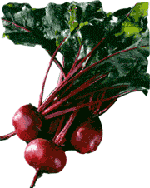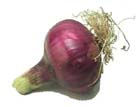|
|
Glossary Selection
Kalamata Olives | |||
| Also Calamata. Purple-black Greek olives cured in vinegar | |||
Zucchini | |||
 | Zucchini (US, Australian, and Canadian English) or courgette (New Zealand and British English) is a small summer marrow or squash, also commonly called Italian squash. Its Latin name is Cucurbita pepo. It can either be yellow or green and generally has a similar shape to a ridged cucumber, though a few cultivars are available that produce round or bottle-shaped fruit. Unlike the cucumber it is usually served cooked, often steamed or grilled. Its flower can be eaten fried or stuffed. Zucchini is commonly thought of as a vegetable, and in layman's parlance, of course, this is more useful; however by strict definition the zucchini is a fruit, being the swollen ovary of the zucchini flower. Zucchini is one of the easiest vegetables to cultivate in a temperate climate. As such, zucchini has a reputation among home gardeners for overwhelming production, and a common type of joke among home growers revolves around creative ways of giving away unwanted zucchini to people who already have been given more than they can use. | ||
Zapote | |||
| Zapote is short for Black zapote. It is similar to the persimmon or plum. In the Philippines, the seeded pulp is served as dessert with a little milk or orange juice poured over it. The addition of lemon or lime juice makes the pulp desirable as a filling for pies and other pastry. It is also made into ice cream. In Mexico, the pulp may be mashed, beaten or passed through a colander and mixed with orange juice or brandy, and then served with or without whipped cream. Also, they sometimes mix the pulp with wine, cinnamon and sugar and serve as dessert. Some Floridians use an eggbeater to blend the pulp with milk and ground nutmeg. A foamy, delicious beverage is made by mixing the pulp with canned pineapple juice in an electric blender. In Central America, the fermented fruits are made into a liqueur somewhat like brandy. In Spanish, it is known variously as sapote, sapote negro, zapote, zapote negro, zapote prieto, zapote de mico, matasano (or matazano) de mico, or ebano. It has been called black persimmon in Hawaii. | |||
Zest | |||
 | Zest is the outer, colored shell of citrus fruit and is often used for baking. Zest has become a synonym for spice, strong flavor or interesting taste. During preparation, as much of the white membrane, which is bitter, should be removed with a vegetable peeler or zester tool. | ||
Vegetable shortening | |||
| Shortening is a semisolid fat used in food preparation, especially baked goods, and is so called because it inhibits the formation of long gluten strands in wheat-based doughs, giving them a short texture (as in shortbread). Shortening can be made from animal fat (lard), but is more commonly a hydrogenated vegetable oil that is solid at room temperature. Shortening has a higher smoke point than butter and margarine, and it has 100% fat content, compared to 80% for butter and margarine. Crisco, a popular brand, was first produced in 1911. | |||
Rösti | |||
| Rösti is a potato dish from Switzerland. It was originally a common breakfast eaten by farmers in the canton of Bern, but today is eaten all over Switzerland. Many Swiss people consider rösti a national dish. It normally is no longer eaten for breakfast but eaten as a sidedish to meat and vegetables. | |||
Beetroot | |||
 | The Beet (Beta vulgaris) is a flowering plant in the family Amaranthaceae, native to the coasts of western and southern Europe, from southern Sweden and the British Isles south to the Mediterranean Sea. Beetroot can be cooked and then eaten warm with butter (after having been peeled) as a delicacy; cooked and pickled and then eaten cold as a condiment; or peeled raw and shredded and then eaten as a salad. The leaves and stems can be steamed briefly as a vegetable, although this is preferably done with young plants. These and older leaves and stems can be sliced and stir-fried and have a flavour resembling taro leaves. | ||
Bermuda onion | |||
 | also called Spanish onion or a sweet onion. | ||
Cabanossi | |||
| is pepperoni. | |||
Capsicum | |||
| Capsicum is a genus of plants from the nightshade family (Solanaceae). Some of the members of Capsicum are used as spices, vegetables, and medicines. The fruit of Capsicum plants is commonly known as chile pepper or just pepper. The fruit of most species of Capsicum contains capsaicin (methyl vanillyl nonenamide), a lipophilic chemical that can produce a strong burning sensation in the mouth. Capsicum fruits and peppers can be eaten raw or cooked. They are also frequently used both chopped and raw in salads, or cooked in stir-fries or other mixed dishes. They can be sliced vertically and fried, or chopped and incorporated into salsas or other sauces. They can be preserved by drying or pickling. Dried peppers may be reconstituted whole, or processed into flakes or powders. Pickled or marinated peppers are frequently added to sandwiches or salads. Extracts can be made and incorporated into hot sauces. | |||




